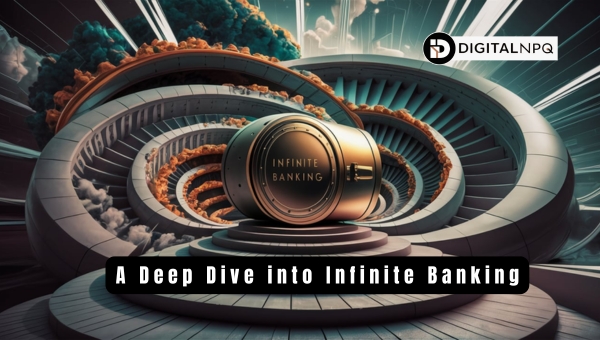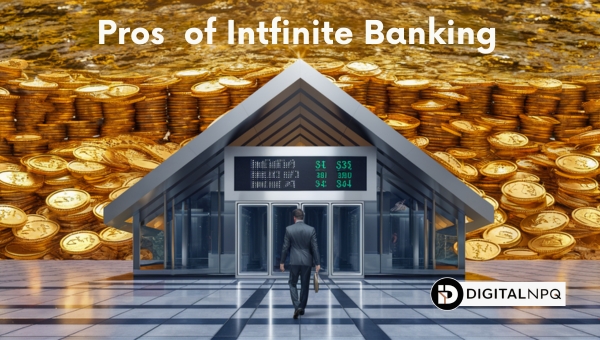Infinite Banking: Your Path to Financial Freedom Now!

Are you eager to take control of your financial future? Infinite Banking might be the solution you need. This article will delve deep into the concept, explaining how it works, its pros and cons, and real-life applications.
We’ll also guide you through the steps to start your own Infinite Banking policy. By the end, you’ll understand the best age to begin and how this method can transform your wealth management. Let’s dive in and unlock the potential of Infinite Banking for you.
A Deep Dive into Infinite Banking
Infinite Banking is a financial strategy that uses whole life insurance to create a self-sustaining system for managing wealth.

By leveraging the cash value of a specially designed whole-life policy, individuals can gain control over their finances and cash flow. This approach allows policyholders to build cash value that grows over time, and they can borrow against this value for various needs.
Key elements include:
- Whole Life Insurance Policy: The foundation of Infinite Banking.
- Cash Value Accumulation: Funds grow tax-deferred within the policy.
- Policy Loans: Access funds without traditional bank loans.
Infinite Banking empowers individuals to take charge of their financial future, offering benefits like tax advantages, guaranteed returns, and flexible access to loans.
How Does Infinite Banking Work?
Infinite Banking revolves around the concept of using a whole life insurance policy to create a personal banking system. Let’s break down how this process works:

Creating Your Infinite Banking Structure
- Acquire a Participating Whole Life Insurance Policy: Start by obtaining a whole life insurance policy from a mutual insurance company. This type of policy is essential because it accumulates cash value over time and pays dividends.
- Work with a Knowledgeable Agent: Collaborate with a knowledgeable insurance agent who understands the infinite banking concept. This ensures the policy is structured to maximize cash value growth and compounding.
Seeding Your Whole Life Insurance with Reserves
- Fund Your Policy with Reserves: Contribute as much as you can into the policy early on. This initial funding, often referred to as “seeding,” helps accelerate the growth of the cash value.
- Accelerate Cash Value Growth: The more you put into the policy, the faster your cash value grows. This is crucial for accessing loans and managing your wealth effectively.
Funneling Cash Flows Through the System
- Utilize the Cash Value for Purchases: Instead of using traditional banks, use your policy’s cash value to make purchases, investments, or cover expenses. This allows your money to keep growing within the policy.
- Take Loans Against the Policy: When you need funds, you can take a loan against your policy’s cash value. These loans are generally easy to access and come with flexible terms.
- Repay Loans on Your Terms: You have the flexibility to repay the loans on your own schedule. This helps in managing cash flow during different financial situations.
Compounding and Growth
- Earn Dividends: As a policyholder with a mutual insurance company, you receive dividends. These dividends can be reinvested into the policy to further increase the cash value.
- Tax-Deferred Growth: The cash value within the policy grows tax-deferred. This means you do not pay taxes on the growth until you withdraw it, making it a tax-efficient strategy for building wealth.
Maintaining and Monitoring
- Regularly Review Your Policy: It’s important to regularly review your policy with your insurance agent to ensure it continues to meet your financial goals.
- Adjust Contributions as Needed: Depending on your financial situation, you may need to adjust your contributions to the policy to optimize growth and benefits.
Leveraging for Wealth Management
- Manage Wealth Effectively: By using the cash value of your policy, you can effectively manage your wealth, making purchases, and investments, and covering expenses while your money continues to grow.
- Create a Self-Sustaining System: Over time, the goal is to create a self-sustaining system where the policy’s cash value and dividends provide you with financial flexibility and security.
Infinite Banking is a powerful financial strategy that requires careful planning and execution. By understanding and implementing these steps, you can leverage your whole life insurance policy to create a personal banking system, manage your wealth, and achieve financial independence.
Also Read: Child Tax Credit 2024: Maximize Your Payments
Pros of Infinite Banking
Infinite Banking offers numerous benefits, making it an attractive option for many. The following sections will delve into the tax advantages, guaranteed returns, easy access to loans, and flexible repayment terms associated with this strategy.

Tax Benefits
Infinite Banking comes with several tax advantages that can be quite beneficial:
- Tax-deferred growth: The cash value of a whole life insurance policy grows tax-deferred, meaning you don’t pay taxes on the gains as they accumulate.
- Tax-free loans: When you borrow against your policy, the loan is generally not considered taxable income, providing a tax-efficient way to access funds.
- Potential estate tax benefits: In some cases, the death benefit can be structured to minimize estate taxes for your beneficiaries.
Guaranteed Returns
One of the most appealing aspects of Infinite Banking is the guaranteed returns:
- Stable growth: Whole life insurance policies offer a guaranteed rate of return, providing stability and predictability in your financial planning.
- Dividend potential: In addition to guaranteed returns, many policies from mutual insurance companies pay dividends, which can further enhance your cash value over time.
- Protection against market volatility: The guaranteed returns provided by whole life policies protect your investments from market downturns.
Easy Access to Loans
Accessing loans through Infinite Banking is straightforward and offers several advantages:
- Quick access: Policyholders can easily borrow against the cash value of their whole life insurance policy without lengthy approval processes.
- No credit checks: Loans against your policy don’t require credit checks, making it easier to obtain funds regardless of your credit score.
- Flexible usage: The borrowed funds can be used for any purpose, from personal expenses to investment opportunities.
Flexibility with Repayments
The repayment terms for loans taken against your policy are highly flexible:
- Set your own terms: You can choose the repayment schedule that best suits your financial situation, whether it’s short-term or long-term.
- No mandatory repayment: Unlike traditional loans, there is no obligation to repay the loan by a specific date. The outstanding loan balance is simply deducted from the death benefit if unpaid.
- Interest flexibility: The interest rates on policy loans are typically lower than those of traditional loans, offering cost-effective borrowing.
These pros highlight why many people consider Infinite Banking an effective and versatile financial strategy. By understanding these advantages, you can better assess if it aligns with your financial goals.
Also Read: Social Security and Medicare Tax: You Need to Know
Cons of Infinite Banking
Infinite Banking offers several advantages, but it’s not without its drawbacks. Let’s delve into some of the challenges you might face when considering this financial strategy.
High Costs
One of the primary concerns with Infinite Banking is the high initial costs and ongoing expenses.
- Setting up a whole life insurance policy can require significant upfront payments.
- Monthly premiums may be more expensive compared to other types of insurance.
- There are also ongoing maintenance costs that can add up over time, making it a long-term financial commitment.
Slow Cash Value Accumulation
Another downside is the slow pace at which cash value accumulates in these policies, especially in the beginning.
- In the initial years, a substantial portion of your premiums goes toward administrative costs and commissions.
- This means it can take several years before you see significant growth in your cash value.
- Patience and consistent funding are crucial, but this slow buildup can be discouraging for some.
Complexity of the System
Managing an Infinite Banking system can be quite complicated, requiring a high level of financial literacy and discipline.
- The system involves numerous components like policy loans, interest rates, and repayment schedules.
- Understanding how to maximize benefits while minimizing costs can be challenging.
- Many people find the intricacies of policy management overwhelming, necessitating the need for a knowledgeable advisor.
These factors make Infinite Banking a strategy that requires careful consideration and planning. While it offers unique benefits, it’s essential to weigh these cons to ensure it aligns with your financial goals and capabilities.
Real-Life Applications of Infinite Banking
Infinite Banking isn’t just a concept; it has been successfully applied in various real-life scenarios. From paying off debts to investing in real estate, this method offers practical solutions for financial management.
Case Studies
Let’s explore real-life examples where individuals have effectively used Infinite Banking.
- Business Expansion: Some entrepreneurs have used their whole life policies to fund business ventures, allowing them to bypass traditional financing methods. This helps in maintaining control and reducing interest expenses.
- Retirement Planning: Others have leveraged Infinite Banking to create a steady retirement income. By borrowing against the cash value, they can access funds without depleting their savings.
- Education Funding: Parents have used these policies to pay for their children’s education, providing a flexible and tax-efficient way to cover tuition fees.
Debt Relief
Infinite Banking can also be a powerful tool for managing and relieving personal debt.
- Credit Card Debt: By borrowing against their whole life policy, individuals can pay off high-interest credit card debt. This can lower overall interest payments and simplify debt management.
- Mortgage Payments: Homeowners can use the cash value to make mortgage payments, reducing their financial burden during tough times.
- Student Loans: Graduates facing high student loan payments can benefit by using their policy’s cash value to pay down these debts, potentially reducing the interest paid over time.
Real Estate Investing
Investors often turn to Infinite Banking to fund real estate purchases and investments.
- Property Acquisition: Investors can use the cash value of their policies to make down payments or purchase properties outright, avoiding traditional mortgage routes.
- Renovation Funding: Funds can be borrowed against the policy to cover renovation costs, increasing the property’s value without incurring high-interest loans.
- Rental Income: By using their policy’s cash value, investors can quickly seize opportunities in the rental market, generating additional income streams.
These examples illustrate how Infinite Banking can be a versatile tool in various financial situations, providing both flexibility and control.
Alternatives to Infinite Banking
When exploring financial strategies, it’s useful to consider alternatives to Infinite Banking. Let’s delve into two notable options: Indexed Universal Life (IUL) and Traditional Bank Savings. These methods offer different benefits and drawbacks, making it crucial to understand them thoroughly.
Indexed Universal Life (IUL)
Indexed Universal Life policies serve as a compelling alternative to Infinite Banking. Here’s a detailed look:
- Potential for Higher Returns: Unlike Infinite Banking’s whole life policies, IUL policies are tied to market indexes. This means there’s a potential for higher returns, although they come with increased risk.
- Flexibility: IUL offers flexible premium payments and death benefits, which can be adjusted based on your financial situation.
- Cash Value Growth: The cash value in IUL grows tax-deferred and can be accessed for loans, similar to Infinite Banking, but with a different growth dynamic tied to index performance.
- Market Risk: While there’s potential for higher returns, these policies also expose you to market risk, which can affect the policy’s cash value.
Traditional Bank Savings
Traditional bank savings accounts are another alternative to Infinite Banking. Let’s break down the pros and cons:
- Simplicity: Traditional savings accounts are easy to manage and understand. They don’t require the same level of financial literacy as Infinite Banking.
- Liquidity: Funds in a savings account are readily accessible without the need for loans or complex structures.
- Lower Returns: Savings accounts typically offer lower interest rates compared to the returns on whole life insurance policies used in Infinite Banking.
- Limited Tax Benefits: Unlike the tax-deferred growth in Infinite Banking, interest earned in savings accounts is taxable.
By comparing these alternatives, you can make an informed decision about which financial strategy aligns best with your goals and risk tolerance.
Also Read: Credit One Bank Card: Your Guide to Features and Management
Steps to Start Your Infinite Banking Policy
Starting your Infinite Banking policy can be a transformative financial decision. However, it involves careful planning and understanding. Let’s break down the crucial steps to help you get started on the right foot.
Choosing the Right Agent
Selecting a qualified agent or advisor is pivotal in setting up your Infinite Banking policy. Here are some tips to guide you:
- Experience Matters: Look for an agent with a proven track record in Infinite Banking and whole life insurance.
- Credentials and Reviews: Check for relevant certifications and read client reviews to gauge their reliability.
- Transparency: Ensure the agent clearly explains all costs, benefits, and potential drawbacks of the policy.
Understanding Whole Life Products
Before committing to an Infinite Banking policy, it’s essential to fully understand whole life insurance products. Consider the following points:
- Policy Features: Familiarize yourself with the key features of whole life insurance, such as cash value accumulation and death benefits.
- Cost Analysis: Evaluate the premium payments and understand how they fit into your long-term financial plans.
- Potential Returns: Study the guaranteed returns and dividends offered by the policy to assess its financial viability.
By following these steps, you can lay a solid foundation for your Infinite Banking journey.
FAQs
Is infinite banking a good idea?
Infinite Banking can be a good idea for those looking to gain more control over their finances. It offers benefits like tax advantages and easy access to loans, but it’s crucial to understand the costs and complexities involved.
Where can I start with infinite banking?
To start with Infinite Banking, you should consult with a knowledgeable agent who specializes in whole life insurance. They can help you set up a policy tailored to your financial goals.
How much can I borrow from my life insurance policy?
The amount you can borrow from your life insurance policy depends on the cash value that has accumulated. Typically, you can borrow up to 90% of the cash value in your policy.
Conclusion
Infinite Banking offers a unique approach to managing your wealth, leveraging whole life insurance to create a personal banking system. It provides tax benefits, guaranteed returns, and easy access to loans, making it a compelling option for those looking to optimize their finances.
However, the high costs, slow cash value accumulation, and complexity can be challenging. Assess your financial goals and consult with a knowledgeable agent to determine if this strategy suits you. By understanding both the pros and cons, you can make an informed decision about incorporating Infinite Banking into your financial plan. Interested in learning more? Explore our other informative blogs for more insights!
